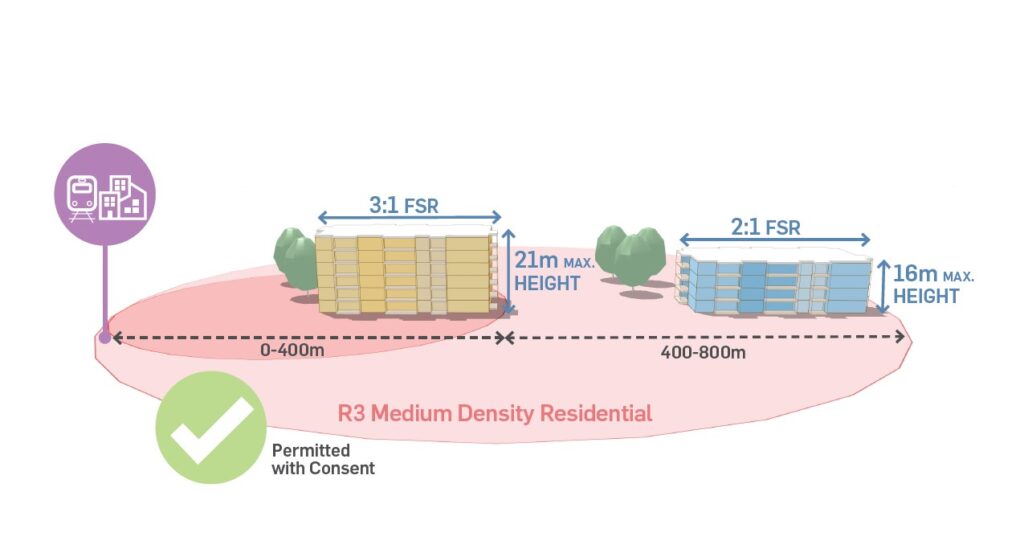The NSW Government has announced a radical overhaul of planning laws that could transform the landscape of housing across the state for generations to come.
The Federal Government, in conjunction with the States, Territories and Local Governments, released the National Housing Accord in November 2022 and agreed in August 2023 to build 1.2 million new well‑located homes over 5 years from mid‑2024. Each state received a mandate, with NSW signing up to build 377,000 homes, or roughly 75,000 homes a year and 31% of the overall national allocation.
These reforms are seen as a critical solution to the worsening housing supply shortage problem. At the heart of these reforms are two major pillars:
- Policies to boost ‘Diverse and Well-Located Homes’ through rezoning that allows for more low-rise and medium-density housing; and
- A ‘Transport Oriented Development Program’ focused on permitting higher density around 45 major transport hubs around NSW.
1. Diverse and Well-Located Homes
The diverse and well-located housing reforms are being introduced across the broader Six Cities Region, spanning from Newcastle to Wollongong and extending to Western Sydney’s Bradfield city. They focus on rezoning areas near transport hubs and amenities.

The reforms mandate that councils permit medium density residential flat buildings and shop top houses on R3 zoned land, allowing for buildings up to 21m or 6 storeys within 0-400m of transit hubs and 16 meters or 4-5 storeys within 400-800m.

The new rules permit the development of “missing middle” housing types like terraces, townhouses, and manor homes on R2 zoned land, which previously only allowed detached housing. The reforms will override local council objections through state planning laws, such as the State Environmental Planning Policy (SEPP), utilising “non-refusal standards” to enforce compliance.

2. Transport Oriented Development (‘TOD’) Program
The TOD in Sydney is a comprehensive urban planning initiative centred on leveraging transport infrastructure to deliver more well-located homes, close to public transport, jobs and services. Divided into 2 parts, the program aims to streamline development processes and address housing shortages.
Part 1 focuses on fast-tracking development in 8 “accelerated precincts” within 1,200m of major stations, offering expedited approval pathways for high and mid-rise housing projects. The rezonings, to take place between September and November 2024, are expected to create, over the next 15 years, capacity for up to 47,800 new well-located homes.
The 8 TOD Accelerated Precincts include Bankstown, Bays West, Bella Vista, Crows Nest, Homebush, Hornsby, Kellyville and Macquarie Park.

Part 2 involves rezoning 37 additional precincts to accommodate taller apartment buildings near well-located and well-connected stations. The new regulations will supersede existing housing policies, providing more generous allowances for development. New planning controls will allow residential flat buildings in all residential zones (R1, R2, R3, R4), and residential flat buildings and shop top housing in local and commercial centres (E1, E2), within 400m of identified stations. Projected to create capacity for 175,000 new homes over the next 15 years, this phase of the program commenced in April 2024.
The list of 37 TOD additional precincts are follows:
- Adamstown
- Booragul
- Corrimal
- Gordon
- Hamilton
- Killara
- Kogarah
- Kotara
- Lidcombe
- Lindfield
- Morisset
- Newcastle Interchange
- Roseville
- Teralba
- Turella
- Wyong
- Banksia
- Dapto
- Gosford
- Rockdale
- Tuggerah
- Berala
- Canterbury
- North Strathfield Metro
- Ashfield
- Dulwich Hill
- Marrickville
- Croydon
- North Wollongong
- St Marys Metro
- Wiley Park
- Cardiff
- Woy Woy
- Belmore
- Lakemba
- Cockle Creek
- Punchbowl

Thank you for reading!

